�
Game Theory for Applied
Economists
Robert Gibbons
Princeton University Press
Princeton, New Jersey
Contents
1 Static Games of Complete Information
1.1 Basic Theory: Normal-Form Games and Nash
Equilibrium. . . . . . . . . . . . . . . . . . . . .
1.1.A Normal-Form Representation of Games.
1.1.B
Iterated Elimination of Strictly Dominated
Strategies . . . . . . . . . . . . . . . . . . .
1
2
2
1.2 Applications
. . . . . . . .
4
1.1.C Motivation and Definition of Nash Equilibrium 8
14
14
21
22
27
1.2.A Coumot Model of Duopoly
1.2.B Bertrand Model of Duopoly
1.2.C Final-Offer Arbitration
. . .
1.2.D The Problem of the Commons
1.3 Advanced Theory: Mixed Strategies and
. . . . . . . .
Existence of Equilibrium
1.3.A Mixed Strategies . . . . . . . . .
1.3.B Existence of Nash Equilibrium .
1.4 Further Reading
1.5 Problems
1.6 References ...
2 Dynamic Games of Complete Information
2.1 Dynamic Games of Complete and Perfect
29
29
33
48
48
51
55
57
Information. . . . . . . . . . . . . . . .
2.1.A Theory: Backwards Induction . . .
57
2.1.B Stackelberg Model of Duopoly. . .
61
2.1.C Wages and Employment in a Unionized Firm 64
68
2.1.D Sequential Bargaining . . . . . . . . . .
2.2 Two-Stage Games of Complete but Imperfect
Information. . . . . . . . . . . . . . . . . . . .
71
�
viii
CONTENTS
2.2.A Theory: Subgame Perfection .
2.2.B Bank Runs
. . . . . . . . . . .
2.2.C Tariffs and Imperfect International
Competition
2.2.D Tournaments .
2.3 Repeated Games . . .
2.3.A Theory: Two-Stage Repeated Games
2.3.B Theory: Infinitely Repeated Games
2.3.C Collusion between Coumot Duopolists .
2.3.0 Efficiency Wages . . .. . . . . .
2.3.E Time-Consistent Monetary Policy
2.4 Dynamic Games of Complete but
Imperfect Information. . . . . . . . . . .
2.4.A Extensive-Form Representation of Games
2.4.B Subgame-Perfect Nash Equilibrium
2.5 Further Reading
2.6 Problems
2.7 References
. . . . . . .
3 Static Games of Incomplete Information
71
73
75
79
82
82
88
. 102
. 107
112
115
115
. 122
. 129
130
. 138
143
3.1 Theory: Static Bayesian Games and Bayesian Nash
Equilibrium . . . . . . . . . . . . . . . . . . . . . 144
3.1.A An Example: Cournot Competition under
Asymmetric Information
. . . . . . . .
3.1.B Normal-Form Representation of Static
Bayesian Games . . . . . . . . . . . . .
3.1.C Definition of Bayesian Nash Equilibrium
3.2 Applications
. . . . .
3.2.A Mixed Strategies Revisited
3.2.B An Auction . . . . .
3.2.C A Double Auction .
The Revelation Principle
Further Reading
Problems
References
3.3
3.4
3.5
3.6
II Dynamic Games of Incomplete Information
Introduction to Perfect Bayesian Equilibrium.
4.1
4.2 Signaling Games . . . . . . . . . . . . . .
4.2.A Perfect Bayesian Equilibrium in Signaling
.144
.146
.149
.152
152
.155
.158
164
.168
.169
.172
173
. 175
. 183
Games. . . . . . . . . . . . . . . . . . . .. .183
�
Contents
4.3
Job-Market Signaling
4.2.B
. . . . . . . . . . . . .
4.2.C Corporate Investment and Capital Structure
4.2.0 Monetary Policy . . . . . . . . .
Other Applications of Perfect Bayesian
Equilibrium . . . . . . . . . . . . .
4.3.A Cheap-Talk Games. . . . . . . .
4.3.B Sequential Bargaining under Asymmetric
Information. . . . . . . . . . . .
4.3.C Reputation in the Finitely Repeated
Prisoners' Dilemma . . . . . . . . .
4.4
4.5
4.6
4.7
Refinements of Perfect Bayesian Equilibrium .
Further Reading
Problems
References
.
Index
ix
.190
. 205
.208
.210
.210
.218
.224
.233
.244
.245
.253
257
�
Preface
Game theory is the study of multiperson decision problems. Such
problems arise frequently in economics. As is widely appreciated,
for example, oligopolies present multiperson problems -
each
firm must consider what the others will do. But many other ap
plications of game theory arise in fields of economics other than
industrial organization. At the micro level, models of trading
processes (such as bargaining and auction models) involve game
theory. At an intermediate level of aggregation, labor and finan
cial economics include game-theoretic models of the behavior of
a firm in its input markets (rather than its output market, as in
an oligopoly). There also are multiperson problems within a firm:
many workers may vie for one promotion; several divisions may
compete for the corporation's investment capital. Finally, at a high
level of aggregation, international economics includes models in
which countries compete (or collude) in choosing tariffs and other
trade policies, and macroeconomics includes models in which the
monetary authority and wage or price setters interact strategically
to determine the effects of monetary policy.
This book is designed to introduce game theory to those who
will later construct (or at least consume) game-theoretic models
in applied fields within economics. The exposition emphasizes
the economic applications of the theory at least as much as the
pure theory itself, for three reasons. First, the applications help
teach the theory; formal arguments about abstract games also ap
pear but playa lesser role. Second, the applications illustrate the
process of model building -
mal description of a multiperson decision situation into a formal,
game-theoretic problem to be analyzed. Third, the variety of ap
plications shows that similar issues arise in different areas of eco
nomics, and that the same game-theoretic tools can be applied in
the process of translating an infor
�
xii
PREFACE
each setting. In order to emphasize the broad potential scope 01 :
the theory, conventional applications from industrial organization.
largely have been replaced by applications from labor, macro, and
other applied fields in economics. l
We will discuss four classes of games: static games of com
(A game has incomplete information if one
plete information, dynamic games of complete information, static
games of incomplete information, and dynamic games of incom
plete information.
player does not know another player's payoff, such as in an auc
tion when one bidder does not know how much another bidder
is willing to pay for the good being sold.) Corresponding to these
four classes of games will be four notions of equilibrium in games:
Nash equilibrium, subgame-perfect Nash equilibrium, Bayesian
Nash equilibrium, and perfect Bayesian equilibrium.
Two (related) ways to organize one's thinking about these equi
librium concepts are as follows. First, one could construct se
quences of equilibrium concepts of increasing strength, where
stronger (Le., more restrictive) concepts are attempts to eliminate
implausible equilibria allowed by weaker notions of equilibrium.
We will see, for example, that subgame-perfect Nash equilibrium
is stronger than Nash equilibrium and that perfect Bayesian equi
librium in turn is stronger than sub game-perfect Nash equilib
rium. Second, one could say that the equilibrium concept of in
terest is always perfect Bayesian equilibrium (or perhaps an even
stronger equilibrium concept), but that it is equivalent to Nash
equilibrium in static games of complete information, equivalent
to subgame-perfection in dynamic games of complete (and per
fect) information, and equivalent to Bayesian Nash equilibrium in
static games of incomplete information.
The book can be used in two ways. For first-year graduate stu
dents in economics, many of the applications will already be famil
iar, so the game theory can be covered in a half-semester course,
leaving many of the applications to be studied outside of class.
For undergraduates, a full-semester course can present the theory
a bit more slowly, as well as cover virtually all the applications in
class. The main mathematical prerequisite is single-variable cal
culus; the rudiments of probability and analysis are introduced as
needed.
1 A good source for applications of game theory in industrial organization is
Tirole's The Theory of Industrial Organization (MIT Press, 1988).
�
Preface
xiii
I learned game theory from David Kreps, John Roberts, and
Bob Wilson in graduate school, and from Adam Brandenburger,
Drew Fudenberg, and Jean Tirole afterward. lowe the theoreti
cal perspective in this book to them. The focus on applications
and other aspects of the pedagogical style, however, are largely
due to the students in the MIT Economics Department from 1985
to 1990, who inspired and rewarded the courses that led to this
book. I am very grateful for the insights and encouragement all
these friends have provided, as well as for the many helpful com
ments on the manuscript I received from Joe Farrell, Milt Harris,
George Mailath, Matthew Rabin, Andy Weiss, and several anony
mous reviewers. Finally, I am glad to acknowledge the advice and
encouragement of Jack Repcheck of Princeton University Press and
finandal support from an Olin Fellowship in Economics at the Na
tional Bureau of Economic Research.
�
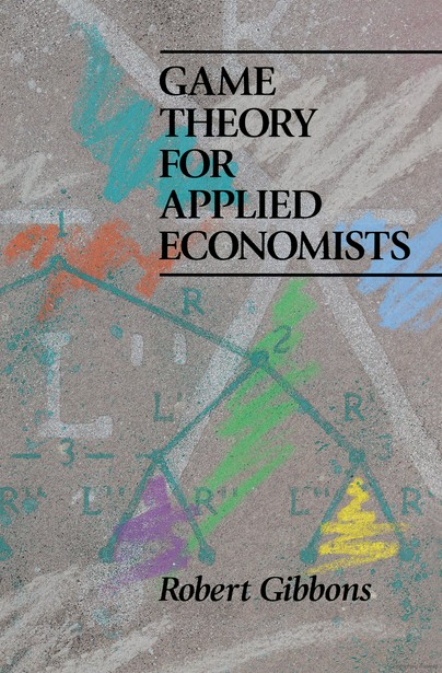
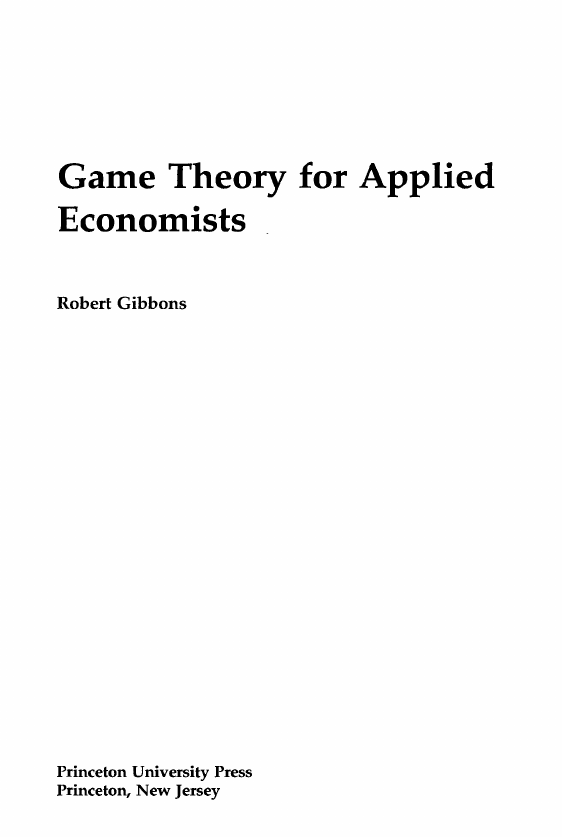
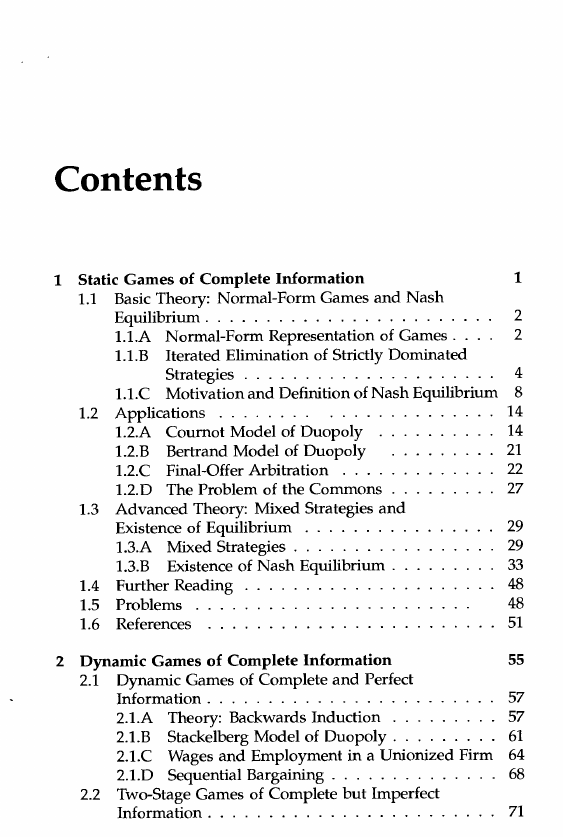
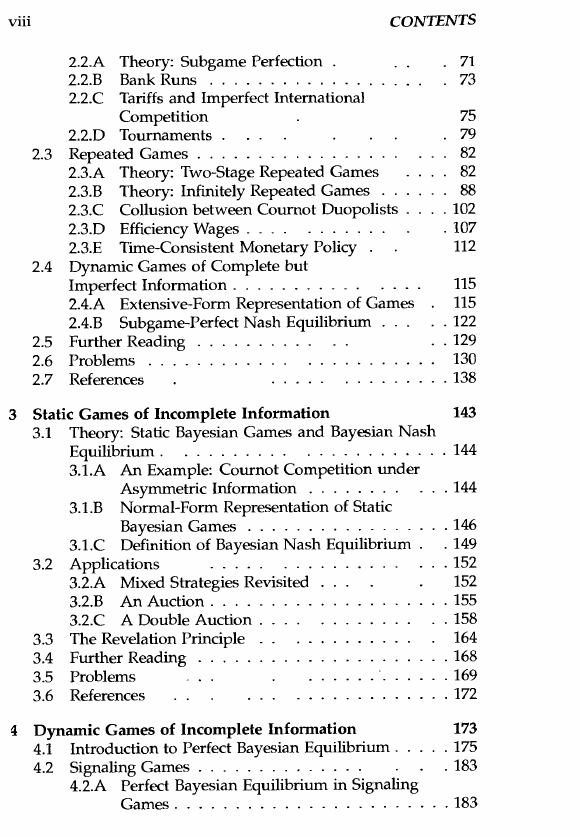
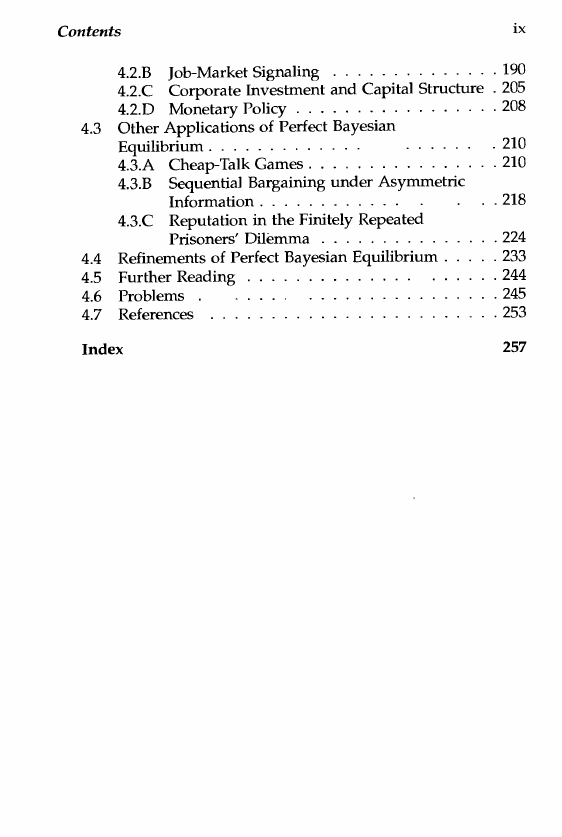
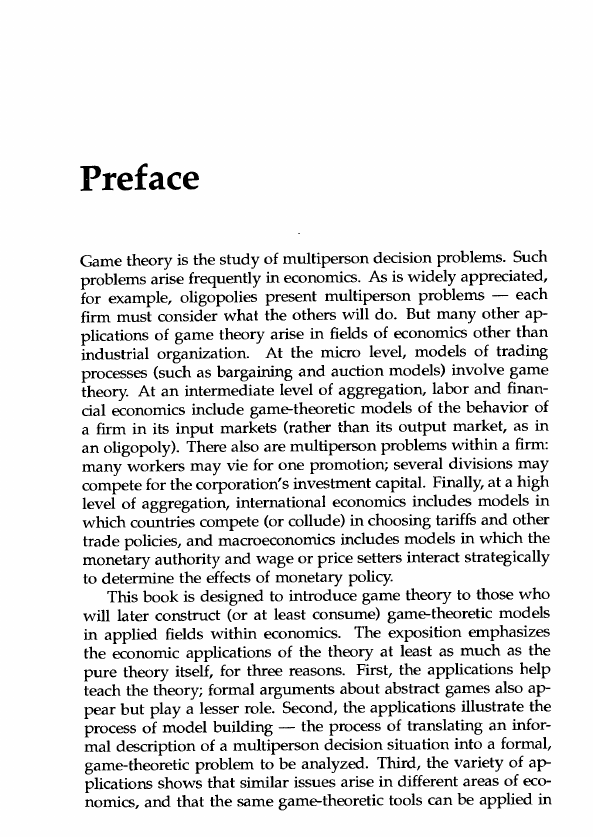
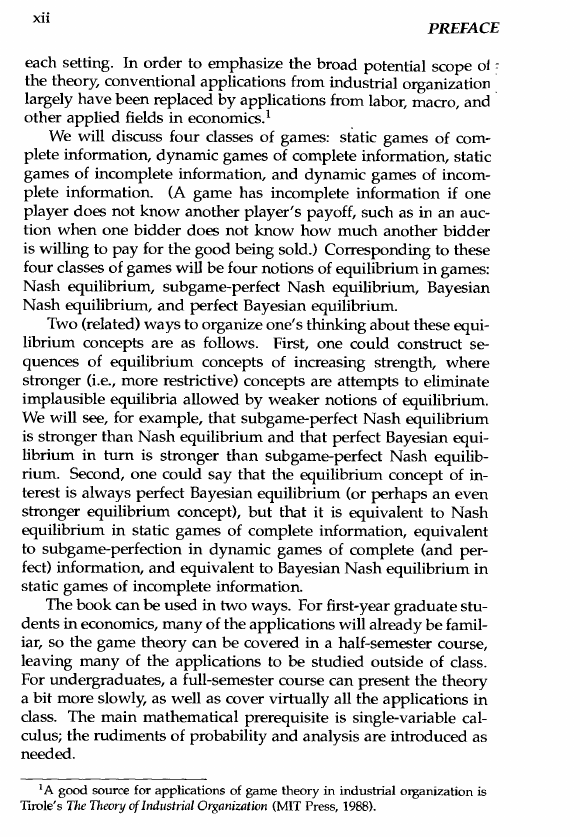









 2023年江西萍乡中考道德与法治真题及答案.doc
2023年江西萍乡中考道德与法治真题及答案.doc 2012年重庆南川中考生物真题及答案.doc
2012年重庆南川中考生物真题及答案.doc 2013年江西师范大学地理学综合及文艺理论基础考研真题.doc
2013年江西师范大学地理学综合及文艺理论基础考研真题.doc 2020年四川甘孜小升初语文真题及答案I卷.doc
2020年四川甘孜小升初语文真题及答案I卷.doc 2020年注册岩土工程师专业基础考试真题及答案.doc
2020年注册岩土工程师专业基础考试真题及答案.doc 2023-2024学年福建省厦门市九年级上学期数学月考试题及答案.doc
2023-2024学年福建省厦门市九年级上学期数学月考试题及答案.doc 2021-2022学年辽宁省沈阳市大东区九年级上学期语文期末试题及答案.doc
2021-2022学年辽宁省沈阳市大东区九年级上学期语文期末试题及答案.doc 2022-2023学年北京东城区初三第一学期物理期末试卷及答案.doc
2022-2023学年北京东城区初三第一学期物理期末试卷及答案.doc 2018上半年江西教师资格初中地理学科知识与教学能力真题及答案.doc
2018上半年江西教师资格初中地理学科知识与教学能力真题及答案.doc 2012年河北国家公务员申论考试真题及答案-省级.doc
2012年河北国家公务员申论考试真题及答案-省级.doc 2020-2021学年江苏省扬州市江都区邵樊片九年级上学期数学第一次质量检测试题及答案.doc
2020-2021学年江苏省扬州市江都区邵樊片九年级上学期数学第一次质量检测试题及答案.doc 2022下半年黑龙江教师资格证中学综合素质真题及答案.doc
2022下半年黑龙江教师资格证中学综合素质真题及答案.doc